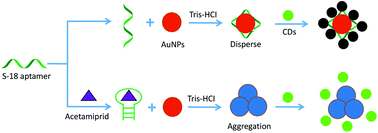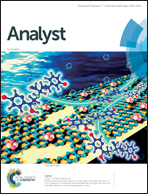A novel fluorescent aptasensor for ultrasensitive and selective detection of acetamiprid pesticide based on the inner filter effect between gold nanoparticles and carbon dots†
Abstract
This paper reports a novel fluorescent aptasensor for the detection of acetamiprid pesticide with high sensitivity and selectivity based on the inner filter effect (IFE) of gold nanoparticles (AuNPs) toward fluorescent carbon dots (CDs). The aptasensor employs S-18 aptamer as the specific target recognition molecule and CDs as the signal transmission element. Free S-18 aptamer sequences can wrap the surfaces of AuNPs and enable their dispersion state even in the presence of high amounts of Tris-HCl salt, which can effectively quench the fluorescence of the CDs through the IFE. Upon adding acetamiprid pesticide, the free S-18 aptamer sequences are firstly exhausted to form some complexes; thus, the AuNPs tend to aggregate and their absorption spectrum no longer overlaps with the fluorescence emission spectrum of the CDs, which leads to obvious fluorescence recovery of the aptasensor. The properties of the CDs were extensively characterized, and the fluorescence quenching effects of the AuNPs toward the CDs were fully investigated. Additionally, the effects of some vital parameters, such as the type and amount of AuNPs, on the fluorescent aptasensor were also investigated. The proposed aptasensor has a detection limit as low as 1.08 μg L−1 with a linear range of 5 to 100 μg L−1 and shows high selectivity for acetamiprid over other control pesticides. Moreover, the aptasensor displays excellent accuracy and recovery in the detection of spiked real samples, suggesting that this fluorescent aptasensor can play important roles in the fields of food analysis and environmental detection.



 Please wait while we load your content...
Please wait while we load your content...